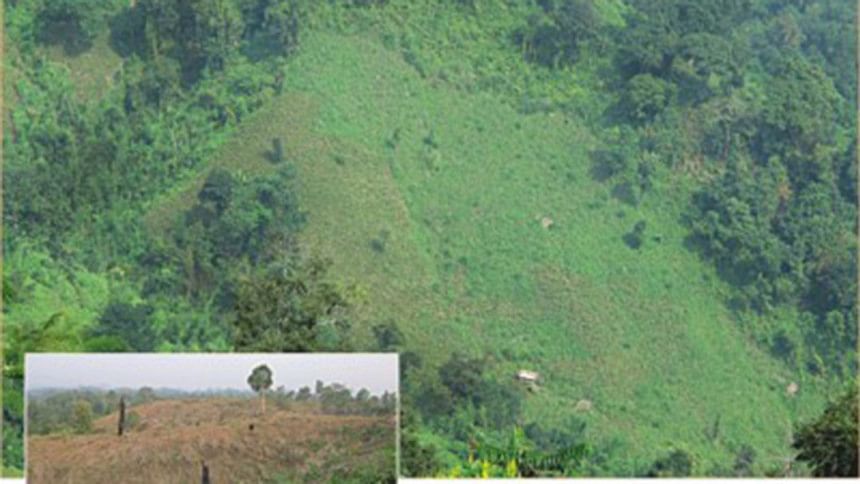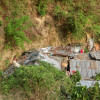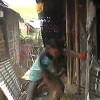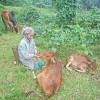Green desert in the hills

All around us is a green desert. What was supposed to be reserved and forest is now just denuded hills. Welcome to Kasalong Reserve Forest.
As our Chander Gari -- a Second World War Willy's Jeep fitted with a Mitsubishi engine -- rolls on the topsy-turvy narrow herringbone road, tossing madly from one side to another and groaning to negotiate the stiff inclines, a horrible scene unfolds before us.
As far as the eyes go, the trees are all gone. Monsoon-fed lush green grass and bush now cover the hills all the way from Marissa to the remote village of Khwang Lakh (kong Lak as it is spelled now) in Sajek. The greenness might elude untrained eyes. But a closer look reveals the degradation. All along the about 30km we traveled from Dighinala to Sajek, hardly ten mother trees are left standing -- or rather they are waiting for their time to go.
"The first time I came here 13 years ago, it was a pristine forest," Suprio Chakma, a local journalist and NGO activist, says. "It is unbelievable how fast it has disappeared in the last six to seven years."
This mighty mixed-evergreen forest spanned 1,645 square kilometers, starting from the tip of Myanmar in the south and east and touching Assam and Tripura in the east and north. It was the richest natural forest that the country could ever have.
The only thought that strikes one's mind after one's coming to Sajek today is: how could this happen? How could we lose this multi billion dollar resource?
"It started since the signing of the peace treaty," Sudip Chakma, a farmer in Bongoltoli, a tumultuous village by the forest, says. The village is today a safe haven for armed UPDF men.
A strange story came out of that statement as we talked to villagers around. And the same story was repeated way further up in Chhipui and Rui Loui villages in Sajek.
Kasalong stood tall and proud as long as the Shanti Bahini insurgency lasted. The hills people formed the Shanti Bahini as part of their armed separatist movement in the early 1970s. As the conflict with the government developed, the Shanti Bahini men took shelter in the forest and waged their campaign from there. For their own survival they maintained the thick green cover.
Then in 1997, the Chittagong Hill Tracts Peace Treaty was signed. The insurgents turned in their guns. And then the mass destruction of the forest began. Hordes of Bangali log traders came to the hills, hired the indigenous people and chopped off the trees.
"I got a daily payment of Tk 50 to log the forest," says Moni Tripura. "About 30 of us would enter the forest with long saws and cut down the trees."
Then trucks would haul them off to Rangamati, Bandarban and beyond.
Even after the onslaught, a recognizable forest stood there.
"I have seen a forest that looked like hair standing on the head," Suprio says. "But in the last 10-15 years that also has gone."
What makes the vanishing of the forest so striking is the fact that there is only one way to take the logs out of the hills the one and only road that runs all the way to Sajek. On the way one finds at least six army, police and forest department check posts. So the question arises: how could the logs be carried through all these points? What did the forest department do to stop it? It was, then, an act of connivance.
And now everywhere new settlements are sprouting on the reserved forest. People are setting up bamboo houses and clear-felling whatever trees are left. And in many cases, the number of trees is so small in number that it makes little sense for the hills people to chop them off. They just set fire to the bush to clear the area for Jhum (slash and burn) farming. In the process the remaining trees get singed and die away. The forest department's monitoring is completely absent. Nor is there any plan to give livelihood to the people to replace jhum.
Today as we stand on top of Sajek valley and look around, we see undulated hills cascading away. We can imagine how the government could use this land to live up to its commitment to fight climate change. How much it could earn in terms of clean development mechanism (CDM) by reforesting this vast land. And how much it could profit in carbon trading just by using this forest.
But the dead forest is just left to be wasted.

 For all latest news, follow The Daily Star's Google News channel.
For all latest news, follow The Daily Star's Google News channel. 







Comments